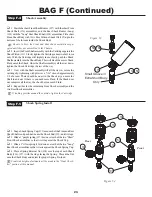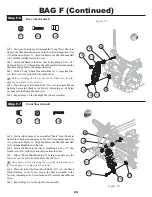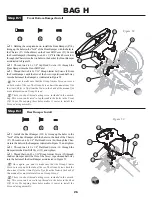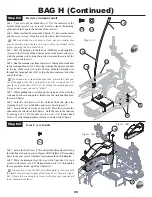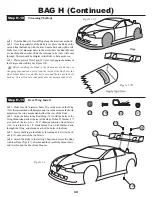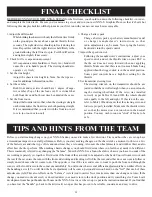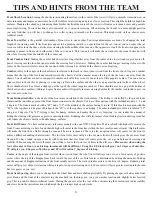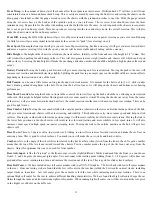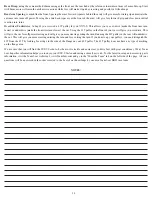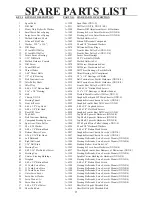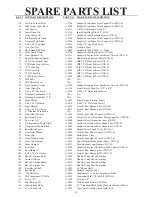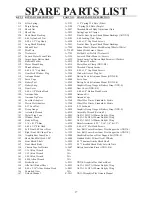
Front Shock Location
; Leaning the shocks in (mounting them closer to the center of the tower) will give a smoother transition as you
enter into turns and improve consistency but will yield less total steering and give a slower reaction. This might be helpful on high bite
surfaces. Standing the shocks up (mounting them further out from the center of the tower) will increase responsiveness and generate
more total steering. Forward traction is also increased, as is on-power steering. When moving the shocks to a more upright position
you may find that you will have to change to a softer spring to smooth out the reaction. This might work well on shorter more
technical tracks.
Front Toe-in/Out
;
is the parallel relationship of front tires to one another. Toe-in/out adjustments are made by changing the total
length of the steering rods. If the front tires appear to be pointing inward to a spot in front of the car (toe-in) you can expect the car
to react a little slower but have a little more steering from the middle of the turn out. The opposite is true if the front tires appear to be
pointing to points in front and to either side of the car (toe-out). This (toe-out) will make the car turn into the corner better but will
allow less steering from the middle of the corner out.
Front Camber Link
; Making the camber link shorter (moving it further away from the center of the tower) tends to give more off-
power steering into the turn but can also make the steering feel a bit erratic. Making the camber link longer (moving it closer to the
center of the tower) will slow down the reaction of the steering but will make the chassis more forgiving.
Camber
;
refers to the angle of the wheels/tires in relation to the track surface when viewed from the front or back. Negative camber
means that the top of the tire leans inward toward the chassis. Positive camber means the top of the tire leans out away from the
chassis. You should never need to run positive camber and will always want to run at least a little negative camber. You can use any
square object to check this by placing it so one edge is flat on the surface and the other is up against the outer surface of the wheel.
There should always be at least a slight gap at the top of the wheel (negative camber). There should never be a gap at the bottom of
the wheel (positive camber). Adding 1 degree front camber will typically increase steering but ideally the camber is adjusted to get even
tire wear across the tire.
Front Kickup/Anti-dive
;
is the angle of the front arms in relation to the track surface. The kickup is controlled by the pivot blocks
that mount the inner hinge pins of the front suspension arms to the chassis. You have three options with the included mounts, 0, 2, and
4 degrees. The front is marked with a "4F" and a "0F" at the middle of the surface facing forward. If this block is mounted with the
"4F" at the top there is 4 degrees of kickup, if the "0F" is at the top there is no kickup. The other included pivot block is labeled "2F"
and gives 2 degrees. The "4F" setting is best for bumpy surfaces and makes the car very forgiving. As you reduce the amount of
kickup the steering will get more aggressive entering the turn. Reducing this will also improve front braking traction entering turns but
will reduce the chassis' ability to handle bumpy surfaces.
Front Roll Center
- We have included new roll center mounts with your XXX-S Graphite. The kit is built with high roll center in the
front. From our testing we have found that the high roll center in the front has yielded the best results on most tracks. High roll center
will make the front drive flatter through a turn and be more responsive There is also an optional low roll center for the front to
achieve different handling characteristics. The low front roll center will give the car more front roll which gives the car more front
traction. We have found on carpet tracks with foam tires that low front roll center gives the car a good balance of steering and
stability. When running the low roll center you will have to use the lower set of holes in the diff cover.
Please note, when using the
low roll center in front, your kick-up increments will be different. Using the 0 F block will give you 2 degrees of anti-dive,
2F will give you 0 degrees of kick-up, and 4F will result in 2 degrees of kick-up.
Caster
; is the angle of the kingpin from vertical when viewed from the side. You will always run zero or a few degrees of positive
caster where the top of the kingpin leans back toward the rear of the car. Total caster is determined by adding the amount of kickup
and the amount of kingpin inclination of the front spindle carriers. The stock spindle carriers in the kit are 4 degree. Reducing total
caster will give less off power steering while giving more on power steering on exit. More caster will give greater steering into the turn
but less power as you exit.
Front Arm Spacing
; allows you to change both the wheel base and driveshaft angle slightly. By placing the spacers between the front
pivot block and the front of the arm (moving the arm back) on the hinge pin, you get a quicker reaction and slightly better forward
grip. This is good for shorter/technical tracks. Placing the spacers all at the rear of the arm (moving the arm forward) adds stability
and slows down the initial reaction which might help on longer high speed tracks.
32
TIPS AND HINTS FROM THE TEAM






